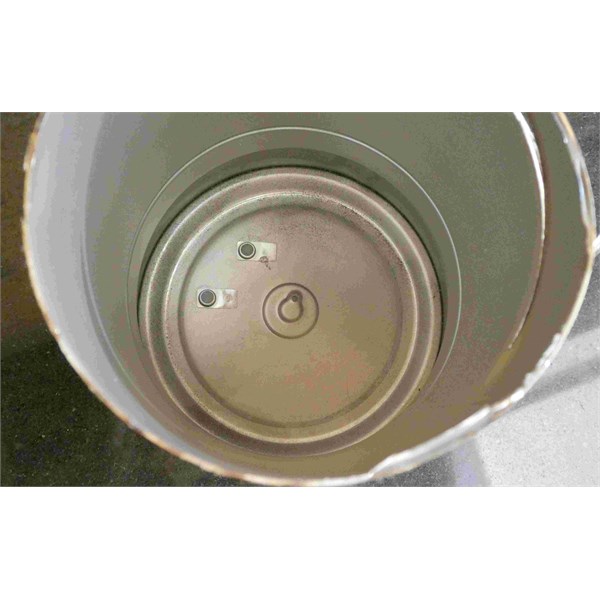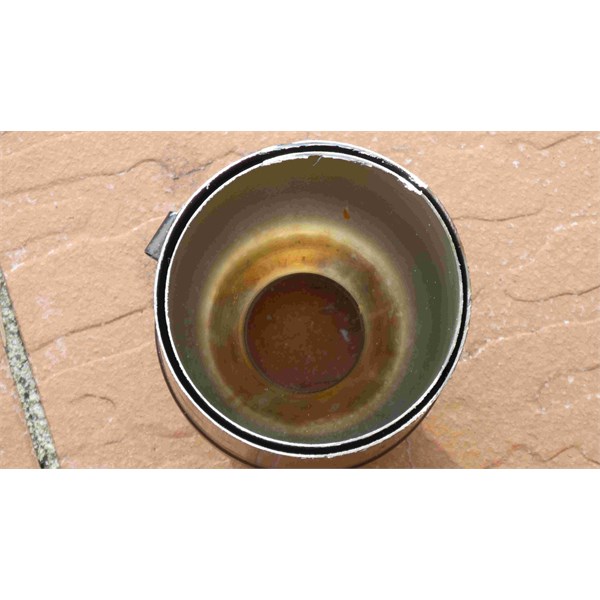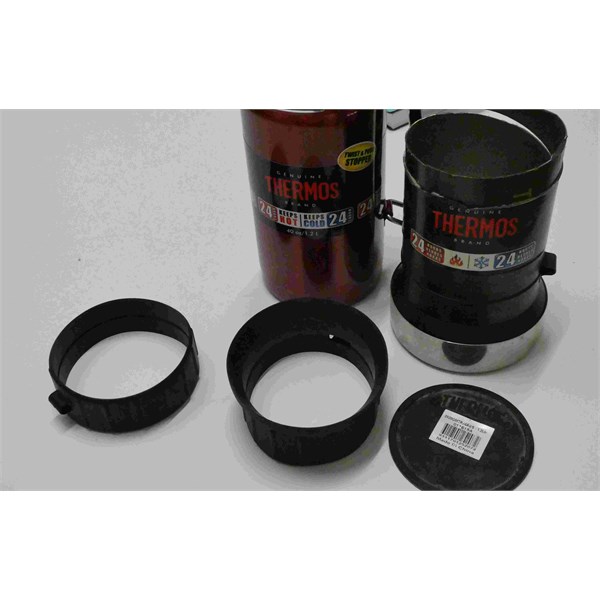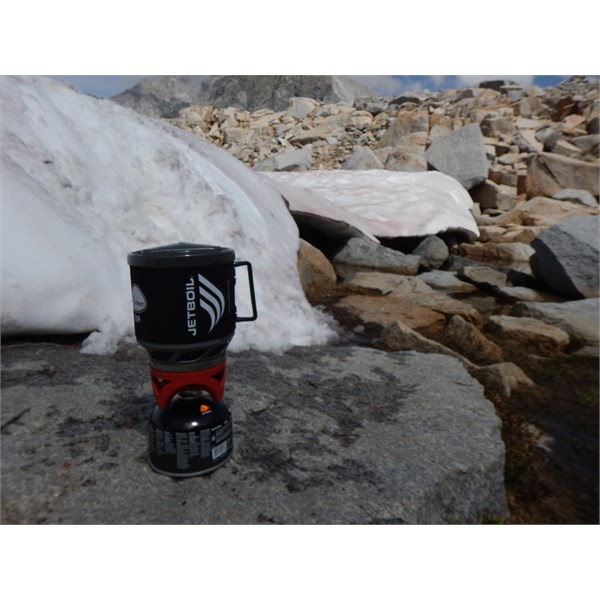Thermos Flask Failures and Deconstruction
Submitted: Tuesday, Oct 29, 2019 at 20:26
ThreadID:
139251
Views:
11205
Replies:
10
FollowUps:
23
This Thread has been Archived
Member - pedro1
Sick of my thermos flasks failing after a couple of years use , I decided to find out why.
Basically construction of two metal walls with a vacuum gap. Any dent will render them useless !
Wouldn't it be good if they had a insulation material between the walls
The inner container appears to sit on two small pads to separate it from the outer base
My new flask has no rubber outside protection or metal protection base compared to the two year old one .
See photos to compare.

Thermos Base

Thermos Walls

Thermos protection compared old to new
I have not much confidence in this product unless I wrap it in bubble wrap
Reply By: Member - DingoBlue(WA) - Tuesday, Oct 29, 2019 at 22:22
Tuesday, Oct 29, 2019 at 22:22
A dent will not render the flask useless. The outer or inner wall needs to be punctured for the flask to fail. A vacuum is the best form of insulation however, if you want to purchase a less efficient foam insulated flask then you wont have any further problems.
Alternatively, you could make sure the flask is transported in such a manner as to protect it from 'dents'
AnswerID:
628413
Follow Up By: Member - pedro1 - Wednesday, Oct 30, 2019 at 00:35
Wednesday, Oct 30, 2019 at 00:35
"A dent will not render the flask useless" Tell that to Thermos
I find that when the inner and outer shell make contact with each other (dent) , heat is quickly lost to the outer heat sink. By the way I received this reply from Thermos :
"Please note, product must be in good condition without any dents.
We will test and inspect the product to see if it meets the warranty requirements. If product meets the warranty requirements, we will send out a replacement at our cost.
However, if after inspection the product warranty claim is not validated, no replacement will be issued, and the cost to return the product will be at your expense, or you can authorise us to destroy it."
FollowupID:
902783
Follow Up By: Zippo - Wednesday, Oct 30, 2019 at 01:26
Wednesday, Oct 30, 2019 at 01:26
Pedro, when the "dent" forms a metal-to-metal bridge across the insulation (vacuum) then of course the thermal isolation will fail. When it DOESN'T, unless either layer is punctured the vacuum will continue to perform.
FollowupID:
902784
Follow Up By: Member - pedro1 - Wednesday, Oct 30, 2019 at 11:22
Wednesday, Oct 30, 2019 at 11:22
It is a small gap between both surfaces, thats why I consider a thin insulating coating applied to the inner wall as
well as having the air gap would be a lot better. As I said , the new flask has even less (no ) external protection than the older flask . Designed to fail me thinks !
FollowupID:
902793
Follow Up By: Member - DingoBlue(WA) - Wednesday, Oct 30, 2019 at 15:52
Wednesday, Oct 30, 2019 at 15:52
Pedro,
there is no air gap, it's a vacuum. Any layer of "insulation" will not be as effective as the vacuum.
We are still using a 'Thermos' that's over 20 years old and still going strong.
FollowupID:
902806
Follow Up By: tim_c - Friday, Nov 01, 2019 at 09:36
Friday, Nov 01, 2019 at 09:36
I wouldn't have thought the metal-to-metal contact caused by the occasional little dent would make a huge difference (yes, it will make *some* difference) - remember at
the neck of the flask there is metal-to-metal contact to hold the inner and outer chambers together and in place.
The issue with a dent is more likely that it can create a small puncture which would cause air to leak into the vacuum chamber.
FollowupID:
902844
Reply By: Gbc.. - Wednesday, Oct 30, 2019 at 06:25
Wednesday, Oct 30, 2019 at 06:25
I still have my original stainless thermos given to me when I started my apprenticeship 30 years ago. To say it is dented is an understatement. It still dispenses coffee That is too hot to drink. My old boy still has his green hammertone
Stanley flask which is older but in better condition. They still sell both models I believe but you’ll be set back $80-100 odd for a decent one.
AnswerID:
628416
Follow Up By: Member - pedro1 - Wednesday, Oct 30, 2019 at 11:18
Wednesday, Oct 30, 2019 at 11:18
I believe the new
Stanley thermos , now made in China instead of America isn't as good as the originals
FollowupID:
902791
Follow Up By: braggy - Wednesday, Oct 30, 2019 at 11:20
Wednesday, Oct 30, 2019 at 11:20
I had a
Stanley that was 35 yrs old and it started to not keep
water hot enough, they replaced it with a brand new one, no charge, they have a life time warranty and they honour it
FollowupID:
902792
Reply By: Phil B (WA) - Wednesday, Oct 30, 2019 at 08:39
Wednesday, Oct 30, 2019 at 08:39
I got sick of luke warm Thermos based hot drinlks years ago - I now use one of these
Jetboil
AnswerID:
628417
Follow Up By: Member - Geoff M (VIC) - Wednesday, Oct 30, 2019 at 10:02
Wednesday, Oct 30, 2019 at 10:02
Another vote for the Jetboil - we have chucked the Thermos and had the Jetboil for a few years ??
FollowupID:
902787
Follow Up By: Idler Chris - Wednesday, Oct 30, 2019 at 10:09
Wednesday, Oct 30, 2019 at 10:09
A Jetboil wins hands down. You boil the exact amount of
water you need and by the time you get a teabag/coffee and milk out of the fridge the
water is boiled, its that quick.
FollowupID:
902788
Follow Up By: Member - Stephen L (Clare SA) - Wednesday, Oct 30, 2019 at 10:11
Wednesday, Oct 30, 2019 at 10:11
Another vote on the fantastic, compact Jetboil.
We have it permanently in the car.
And they are extremely quick to boil
FollowupID:
902789
Follow Up By: Member - pedro1 - Wednesday, Oct 30, 2019 at 12:33
Wednesday, Oct 30, 2019 at 12:33
I agree Jetboil are a brilliant design, however the drawback is the half empty gas cyclinders one gathers over time and has to remember on the next trip to restock .
FollowupID:
902801
Follow Up By: Idler Chris - Wednesday, Oct 30, 2019 at 13:10
Wednesday, Oct 30, 2019 at 13:10
Hi Pedro1, I don't understand why you would have half empty gas cylinders. Why not use all the gas then throw the cylinder out when empty. Cylinders are small, not heavy and readily available at any
camping store, so I fail to see any issue in replacing them. If you do not have a jetboil, any other method is going to be more trouble IMHO.
Chris
FollowupID:
902802
Follow Up By: Member - pedro1 - Wednesday, Oct 30, 2019 at 13:33
Wednesday, Oct 30, 2019 at 13:33
I end up with lots of half used ones when kayaking, hiking where disposal also becomes a issue .
Therefore when doing those activities, I use full ones therefore ending up with half used ones
FollowupID:
902804
Follow Up By: The Explorer - Wednesday, Oct 30, 2019 at 21:25
Wednesday, Oct 30, 2019 at 21:25
Works for me...

JetBoil
Cheers
Greg
| I sent one final shout after him to stick to the track, to which he replied “All right,” That was the last ever seen of Gibson - E Giles 23 April 1874 Lifetime Member
My Profile My Blog Send Message
Moderator |
FollowupID:
902808
Reply By: Member -Pinko (NSW) - Wednesday, Oct 30, 2019 at 12:29
Wednesday, Oct 30, 2019 at 12:29
Given up on thermos for the same reasons as you.
I use one of these, tough and reliable and also heats our shower
water.

Sportster
AnswerID:
628419
Reply By: RMD - Wednesday, Oct 30, 2019 at 23:31
Wednesday, Oct 30, 2019 at 23:31
Pedro1
Did you find out why? seeing cutting them open was to find out the reason. Why did they fail,? Has that been determined? you may not have confidence in that brand but unless you found out why then it is trust with any future purchase.
AnswerID:
628429
Follow Up By: Member - pedro1 - Thursday, Oct 31, 2019 at 02:28
Thursday, Oct 31, 2019 at 02:28
After observing the minimal gap between the inner and outer walls and also the base gap created by two tiny separation pads , I concluded they are indeed a fragile item . Funny enough the old glass vacuum flasks seemed to last for ages .
So the only way forward is to build them up some outer protection and treat them with more caution.
FollowupID:
902809
Reply By: Ron N - Thursday, Oct 31, 2019 at 21:38
Thursday, Oct 31, 2019 at 21:38
As a full-time Thermos flask user since 1965, I can tell you this much - I have never, ever found a full-metal construction Thermos of any brand - and I've bought and used them all - to be of any major usefulness in keeping hot
water hot.
Even the Stanleys I've bought were next to useless, with boiling
water poured into them at 5:00AM or 6:00AM, being just lukewarm at midday on most days.
Even pre-heating them with boiling
water did little to improve their effectiveness.
I found that the cheapest glass Thermos from K-Mart or Target or Coles or Woolies (when they still sold them) were the best Thermos' for keeping
water hot.
The only problem is their fragility, and they need extra-special care.
I missed out on hot drinks more than once by leaving the glass Thermos on the ute
seat, and braking hard to avoid animals, sent the flask crashing to the ute floor, destroying it in the process.
But the bottom line is that the cheap glass flasks are not a great financial loss if broken, and they are quickly replaced by another el-cheapo Chinese flask.
I currently have 2 x 1 litre all-metal Aladdins bought from Bunnings in
Broome last year, and they have only re-inforced my view, that these style of flasks are useless.
I wouldn't have bought them, but the missus won out because she liked their size.
Even preheating for 10 mins with boiling
water and then emptying and refilling again, in the early morning, they are only just barely warm by midday.
Cheers, Ron.
AnswerID:
628448
Follow Up By: tim_c - Friday, Nov 01, 2019 at 09:33
Friday, Nov 01, 2019 at 09:33
That's not been my experience - I've always found the
water too hot to hold my hand under even when pouring out the
water the next day (ie. after 24 hours).
I wouldn't think it would make a huge difference, but do you fill it all the way to the top? I've heard that it keeps them hot longer if they are full (I fill
mine so the
water is right up to the base of the stopper plug).
I had one fail once (just after telling everyone how long this thing kept the
water hot, I poured myself a luke-warm drink - the
water had only been in there for 7 hours) - it was not damaged, I can only assume the vacuum chamber got a leak. It was replaced under warranty, no questions asked - the replacement was good last time I used it.
FollowupID:
902843
Follow Up By: Ron N - Friday, Nov 01, 2019 at 11:57
Friday, Nov 01, 2019 at 11:57
Tim - Yes, I always ensure the Thermos flask is full up to the stopper level, to eliminate any chance of heat dissipation.
Maybe I've just been dead unlucky, and all the metal Thermos' and Aladdins and Stanleys I've ever bought, were duds.
But I still believe that glass is the best insulator, and my experience consistently proves that even the cheapest Chinese glass Thermos flask, still outperforms any full-metal flask.
Cheers, Ron.
FollowupID:
902846
Follow Up By: Bazooka - Friday, Nov 01, 2019 at 23:49
Friday, Nov 01, 2019 at 23:49
I have two older
Stanley's and a couple of new Thermos bottles. All work
well enough but I look after them. It's not a difficult job to protect them while travelling. One of the
Stanley's works much better (100%+ better) than the other because they changed the stopper design, presumably after complaints. The new stoppers simply had a groove and a rubber O ring added to the plastic stopper - works beautifully. Having read comments above I might contact them to get a new stopper for the original. Daughter and partner recently bought me a Jetboil and I have the trusty Kelly kettle. Pros and cons for all of them.
Btw I'm not advocating you try but there are videos showing how to simply and safely (?) refill small gas canisters and plenty of discussion around same if anyone's interested. I gather it's illegal to transport refilled cartridges in the USA, don't know about here.
FollowupID:
902875
Reply By: Iza B - Friday, Nov 01, 2019 at 07:55
Friday, Nov 01, 2019 at 07:55
Since my double wall Thermos style failed, I keep it, full, in the engine bay. Aeropress coffee is best made with about 90 degree
water.
AnswerID:
628457
Follow Up By: Allan B (Sunshine Coast) - Friday, Nov 01, 2019 at 08:11
Friday, Nov 01, 2019 at 08:11
.
Now that's a innovative idea Iza.
FollowupID:
902841
Reply By: Member - Boobook - Friday, Nov 01, 2019 at 08:23
Friday, Nov 01, 2019 at 08:23
Send an email complaint to Rudolf Clausius.
AnswerID:
628458
Follow Up By: RMD - Saturday, Nov 02, 2019 at 15:41
Saturday, Nov 02, 2019 at 15:41
Tony
Is that for forwarding warranty claims and repair, or for a new for old replacement? Only happens once a year so there is some wait time!
FollowupID:
902889
Follow Up By: Ron N - Monday, Nov 04, 2019 at 00:42
Monday, Nov 04, 2019 at 00:42
RMD, you'd better study up on the physicist who figured out the 2 main laws of thermodynamics in the 1850's.
His name does sound like a made-up joke name combining Rudolph and Santa Claus, but Rudolf Clausius was one clever gent, a physicist and a mathematician.
https://en.wikipedia.org/wiki/Rudolf_Clausius
Cheers, Ron.
FollowupID:
902918
Reply By: Allan B (Sunshine Coast) - Friday, Nov 01, 2019 at 11:13
Friday, Nov 01, 2019 at 11:13
.
Pedro,
I am finding some confusion here with the "inner and outer" walls.
There are three walls.... the inner wall of the vacuum flask, the outer wall of the vacuum flask, and the outside shell that surrounds the whole appliance. It is difficult to determine which you are referring to.
I can only imagine that any "dents" are occurring in the outside shell of the appliance. If this dent touches the wall of the vacuum flask then some, but I should think very little, heat transfer would occur.
If impacts to the outside shell are of such magnitude as to dent the vacuum flask outer wall to contact the inner wall then that is a mighty solid impact and may be considered as rough handling. Maybe Thermos are pretty flimsy but my old Aladdin
Stanley is scratched and rusty, but not dented and seems to have a pretty solid outside shell that manages fair handling. Maybe later models are more flimsy?
Incidentally, my first
Stanley lost vacuum soon after purchase and was promptly replaced by the manufacturer without question.
AnswerID:
628469
Follow Up By: Member - pedro1 - Friday, Nov 01, 2019 at 19:15
Friday, Nov 01, 2019 at 19:15
Hi Allan, There are only two walls in these flasks, outer shell and the inner container .
Have another look at the photos.
You may have the answer to why there reliability is so poor compared to the past, if they used to have three walls
in construction but now only have two walls and no outside rubber protection.
All my faulty flask flasks show no major impact damage. Made to fail !
FollowupID:
902860
Follow Up By: Allan B (Sunshine Coast) - Friday, Nov 01, 2019 at 20:20
Friday, Nov 01, 2019 at 20:20
.
Well Pedro, I looked again at your photos more carefully and I now see that yes, there are only two walls.
You have educated me. I have always assumed that the stainless flasks were constructed like the glass ones, with a double walled vacuum flask and a steel outer protective container.
But not so it seems. I have just gone to my workshop and removed the bottom cap from my SS
Stanley flask and I can see that it is an outer of plain steel attached to the stainless inner wall of the flask. There is no third jacket. This outer wall has no dents but has lost some of its painted finish and is showing some light rust.
My flask has not been used for some time so I don't know if it still functions as when new.
I only bought it to use when travelling with friends who like to stop for formal morning-tea with a cuppa and a biscuit. Our routine is to drink
water as we travel and not stop for morning-tea.
Sorry for misunderstanding you.
The classic
Stanley that I have has lost some of the green paint finish and this is then showing faint surface rust which shows that is not part of the stainless steel vacuum flask but a separate plain steel outer container, but I can't get it apart to photograph for you.
FollowupID:
902865
Reply By: Phil G - Saturday, Nov 02, 2019 at 12:11
Saturday, Nov 02, 2019 at 12:11
The 1.8L "Nissan" Deluxe Thermos was recommended to me about 15-20 years ago. Cost over $100 back then but you can still get them for similar money. I carry two of them as our hot
water system - I heat
water on the fire then use the
water for drinking and washing. Tested them last year and both still work as
well as the day they were bought
AnswerID:
628497